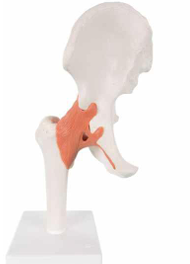رَبِّ زِدْنِي عِلْماً

Functional Hip Joint
Bone And Joint
₹82.00₹22.00
The human hip joint plays a crucial role in our overall mobility and stability, acting as a pivotal connection between the upper body and lower limbs. As a ball-and-socket joint, it is designed for a wide range of movements, including flexion, extension, abduction, adduction, and rotation. This sophisticated structure not only facilitates various activities such as walking, running, and jumping, but also supports the weight of the body during these movements. Anatomically, the hip joint consists of the acetabulum, a cup-like socket in the pelvis, and the femoral head, which is the rounded end of the thigh bone (femur). These two surfaces are covered with articular cartilage, a smooth tissue that reduces friction and absorbs shock. Surrounding the joint is a robust capsule, reinforced by ligaments that provide stability while allowing for the necessary flexibility in movement. The functionality of the hip joint is not merely defined by its anatomical features, but is also influenced by the surrounding musculature. Muscles such as the gluteus maximus, gluteus medius, iliopsoas, and adductors play pivotal roles in hip mechanics. They work collaboratively to enable actions such as raising the leg, stabilizing the pelvis, and maintaining posture. The coordination of these muscles is vital; dysfunction in any one of them can lead to compromised hip function and potential injury. During everyday activities, the hip joint undergoes various stresses. When walking, for instance, the joints must coordinate with multiple muscle groups to maintain balance and facilitate smooth motion. An efficient hip joint also relies on the nearby knee and ankle joints, creating a functional chain that enhances mobility. This interdependence among joints underscores the importance of maintaining a healthy hip joint for overall lower body function. In terms of health, the hip joint is susceptible to a range of conditions such as arthritis, bursitis, and injuries that can significantly impair functionality. Osteoarthritis, for instance, is one of the most common degenerative joint diseases affecting the hip, leading to pain, stiffness, and reduced range of motion. Treatment options can vary, from physical therapy and medications aimed at relieving pain to surgical interventions when necessary. Preventative measures can help maintain hip joint function as well. Regular exercise focusing on strength, flexibility, and stability can enhance not only hip joint health but also overall physical fitness. Low-impact activities such as swimming, cycling, and yoga are particularly beneficial. Additionally, maintaining a healthy weight reduces the strain on hip joints, thereby prolonging their functional integrity. In conclusion, the functional hip joint is essential for mobility and quality of life. Understanding its anatomy, muscle interactions, and the common conditions that can arise is crucial for all individuals, especially those engaged in physical activities or those susceptible to joint-related issues. With proper care, exercise, and awareness of body mechanics, individuals can support their hip joint health and enhance their overall physical performance.
Training
Providing essential healthcare training and simulation solutions.
COntacts
Support
info@medisureinternational.com
+91 9972123423
© Medisure. All Rights Are Reserved
Crafted with ❤️by Influence Kashmir
